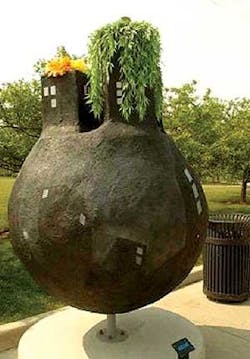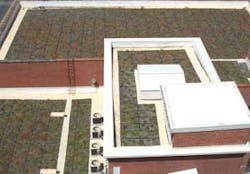Mitigating Stormwater Runoff with Green Roofs
By Jim Lindell
The rate of urbanization in developed countries is continuing to rise, and by year 2030 it is expected to reach 83%. This means cropland, grassland, forests, and other “natural” surfaces will be replaced by streets, parking lots, driveways, and buildings. This will most likely negatively impact the environment in these cities in several ways, and one of the most dramatic may involve the challenge of effectively handling stormwater runoff.
The problem is that the systems for distribution and movement of water will be increasingly taxed, and local communities will find it difficult to cope with the runoff, especially after a major rainfall event. Further complicating matters, it is predicted that climate changes in certain parts of the world may increase these problems and that floods and the risks of floods will become more common in many urban centers.
Currently, the most common management tools for dealing with stormwater runoff are to increase the size and number of storage reservoirs and open up more green areas that will allow runoff to infiltrate or evaporate. Another way to handle the problem is to build more and larger ponds to absorb and store the water. However, as urban areas grow in population and land values increase, these options may become less viable. Growing cities will likely feel increased pressure to designate more open areas for community use, further limiting the amount of forested area that can be set aside just for absorbing runoff.
Another concern about stormwater runoff is the fact that it becomes increasingly polluted as it runs down buildings, streets, gutters, and sidewalks on its way to local treatment centers. Already some localities cannot effectively treat all the runoff after a major rainfall event. In New York City after a major storm, as much as 30% of the runoff is simply released untreated into the East and Hudson rivers, polluting these rivers and harming aquatic and plant life.
Because of these problems, many urban areas in Europe, Asia, and the United States are considering another tool to help reduce stormwater runoff and the problems it can cause. Increasingly, an interesting and viable option has been to install green roofs atop buildings, including homes.
Sometimes referred to as rooftop gardens or vegetative roofs, these intensive green roofs have 8 inches or more of growth media, making them deep enough to allow a diverse number of plants, shrubs, and trees to be planted.
However, this is not the type of green roof usually discussed today. Instead, the most common type of green roof discussed by building architects, planners, and city administrators is an extensive green roof system.
A Closer Look at Green Roofs
An extensive green roof includes approximately two to six inches of lightweight soil known as growth media in which hearty, drought-tolerant sedums and other succulents, herbs, grasses, and mosses are planted. The growth media selected should be engineered soil, a relatively new technology that helps the vegetation thrive and grow with little or no maintenance. Considered the foundation of the green roof, the growth media is mixed with specific chemicals and nutrients to help the plants to survive after the initial installation as well as to thrive in the long term.
Plant selection is also critical and is dependent on the local climate. Vegetation chosen for Chicago or Denver, for example, would likely not be the same as that selected for a green roof atop a building in Texas or Arizona. Additionally, slopes, angles, and the direction of the roof can make a difference in what vegetation is selected. This means planning and consultation with a skilled green roof installer are critical in order for the green roof to perform well.
Originally, green roofs were built directly atop the existing roof-what is known as a built-in-place system. With this type of green roof, the existing roof is first prepared by installing a membrane system along with pavers (optional), a slip sheet to protect the roof membrane, edge elements, and a drip irrigation system to drain stormwater/irrigation not absorbed by the green roof. Once the growth media is installed covering the roof, the vegetation is planted. The entire process can be time consuming and labor intensive.
In recent years, a new technology has been developed that has helped cut the installation time and labor costs. Referred to as a modular green roof, it is actually prepared off-site at a local nursery. Modules, made of 60% recycled plastic, are filled with growth media and vegetation in a factory assembly-line fashion and then installed, one after another, on the existing roof. Although some of the same preparation that goes into a built-in-place roof-such as a membrane system and edge elements-may be required, the modular system has proved to be considerably faster to install and more cost competitive than a green roof built directly on the existing roof.
Building administrators are finding that the modular system can have additional benefits other than just cost savings. Should the existing roof need repair or roof mechanicals, such as the HVAC system, need service, a built-in-place system will likely need to be “dug up” and then re-installed. With the modular system, the modules just need to be picked up and then replaced, which tends to be faster and less costly.
Storing Capacity
As more and more green roofs are installed around the world, more of their benefits, such as helping facilities conserve energy, quieting buildings, reducing the heat island effect that makes core urban centers considerably warmer than outlying and forested areas, and extending the life span of the existing roof, have been noted. However, the best-known benefit of a green roofing system is its ability to store water after a rainstorm and/or reduce or delay the runoff peak, lowering the strain on local treatment facilities so that excess runoff is not released into local waterways.
A test was conducted in Belgium over a 24-hour period to see just how effectively a green roof absorbs stormwater runoff compared to a non-green roof. During this 24-hour period, there were approximately 15 millimeters (0.6 inches) of rain. Runoff from the non-green roof was approximately 13 millimeters, indicating that virtually the entire rain shower event became runoff. However, from the green roof, less than 5 millimeters were released as runoff. The green roof absorbed more than 70% of the water.
Impact on the Urban Area
The Belgium example is just one of many that indicate how effectively a green roof can reduce stormwater runoff. Another study conducted in Brussels set out to illustrate the effect of green roofs on stormwater runoff reduction for the entire city if just 10% of the buildings in the city-considered a conservative figure today-had green roofs installed. Taking into consideration the amount of green space in the city, as well as findings from other studies, which concluded that more than 90% of a rain event became stormwater runoff from buildings with traditional, non-green roofs, the researchers determined that if just 10% of the buildings in Brussels had a green roof, it would reduce the total annual runoff by nearly 3% annually; if a third of the buildings had a green roof, as much as 10% of the runoff could be reduced. The amount would be even higher, the researchers determined, if just the city center were analyzed, excluding the greener suburban areas surrounding the city.
It is quite clear that the addition of green roofs to a city’s buildings can have a significant impact on improving stormwater management. And this can help improve the performance of sewer and water-treatment facilities in these cities as well. This means local waterways and the environment can be better protected.
Another benefit of green roofs is that they do not take away space that might be used for open areas, parks, or even other buildings and development. Instead, they make space by providing a natural refuge in what is usually an unused area of a building. For these reasons, most experts believe that city planners and developers will increasingly begin looking up-at the roofs of their city’s buildings-when looking for ways to improve stormwater management.
About the Author:
Jim Lindell is a marketing professional with Weston Solutions, Inc., manufacturer of the GreenGrid® modular green roof system.


